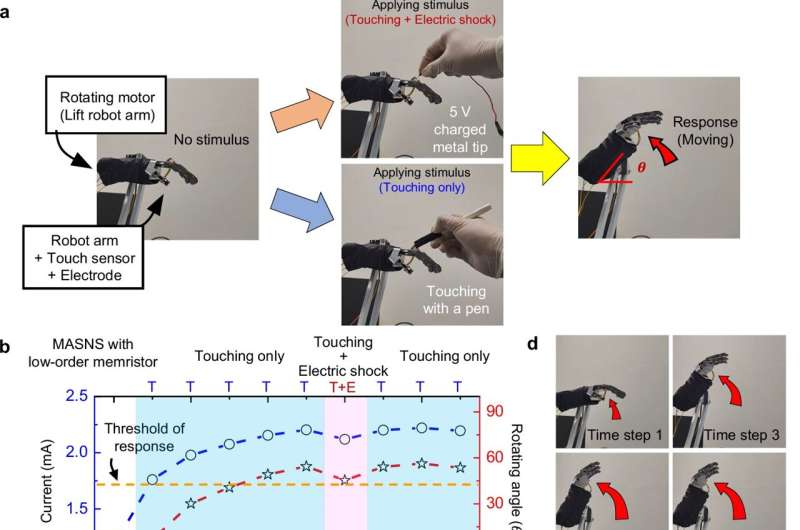
In the midst of the co-development of artificial intelligence and robotic advancements, developing technologies that enable robots to efficiently perceive and respond to their surroundings like humans has become a crucial task. In this context, Korean researchers are gaining attention for newly implementing an artificial sensory nervous system that mimics the sensory nervous system of living organisms without the need for separate complex software or circuitry. This breakthrough technology is expected to be applied in fields such as in ultra-small robots and robotic prosthetics, where intelligent and energy-efficient responses to external stimuli are essential.
KAIST announced on July 15 that a joint research team led by Endowed Chair Professor Shinhyun Choi of the School of Electrical Engineering at KAIST and Professor Jongwon Lee of the Department of Semiconductor Convergence at Chungnam National University developed a next-generation neuromorphic semiconductor-based artificial sensory nervous system. This system mimics the functions of a living organism’s sensory nervous system, and enables a new type of robotic system that can efficiently respond to external stimuli.
The study is published in the journal Nature Communications.
In nature, animals—including humans—ignore safe or familiar stimuli and selectively react sensitively to important or dangerous ones. This selective response helps prevent unnecessary energy consumption while maintaining rapid awareness of critical signals. For instance, the sound of an air conditioner or the feel of clothing against the skin soon become familiar and are disregarded.
However, if someone calls your name or a sharp object touches your skin, a rapid focus and response occur. These behaviors are regulated by the “habituation” and “sensitization” functions in the sensory nervous system. Attempts have been consistently made to apply these sensory nervous system functions of living organisms in order to create robots that respond efficiently to external environments like humans.
However, implementing complex neural characteristics such as habituation and sensitization in robots has faced difficulties in miniaturization and energy efficiency due to the need for separate software or complex circuitry. In particular, there have been attempts to utilize memristors, a neuromorphic semiconductor.
A memristor is a next-generation electrical device which has been widely utilized as an artificial synapse due to its ability to store analog value in the form of device resistance. However, existing memristors had limitations in mimicking the complex characteristics of the nervous system because they only allowed simple monotonic changes in conductivity.
To overcome these limitations, the research team developed a new memristor capable of reproducing complex neural response patterns such as habituation and sensitization within a single device. By introducing additional layer inside the memristor that alter conductivity in opposite directions, the device can more realistically emulate the dynamic synaptic behaviors of a real nervous system—for example, decreasing its response to repeated safe stimuli but quickly regaining sensitivity when a danger signal is detected.
Using this new memristor, the research team built an artificial sensory nervous system capable of recognizing touch and pain, and applied it to a robotic hand to test its performance. When safe tactile stimuli were repeatedly applied, the robot hand, which initially reacted sensitively to unfamiliar tactile stimuli, gradually showed habituation characteristics by ignoring the stimuli.

Later, when stimuli were applied along with an electric shock, it recognized this as a danger signal and showed sensitization characteristics by reacting sensitively again. Through this, it was experimentally proven that robots can efficiently respond to stimuli like humans without separate complex software or processors, verifying the possibility of developing energy-efficient neuro-inspired robots.
See-On Park, researcher at KAIST, stated, “By mimicking the human sensory nervous system with next-generation semiconductors, we have opened up the possibility of implementing a new concept of robots that are smarter and more energy-efficient in responding to external environments.
“This technology is expected to be utilized in various fusion fields of next-generation semiconductors and robotics, such as ultra-small robots, military robots, and medical robots like robotic prosthetics.”
More information:
See-On Park et al, Experimental demonstration of third-order memristor-based artificial sensory nervous system for neuro-inspired robotics, Nature Communications (2025). DOI: 10.1038/s41467-025-60818-x
The Korea Advanced Institute of Science and Technology (KAIST)
Citation:
Robot hand ‘feels’ pain and ignores harmless touch with new sensory system (2025, July 16)
retrieved 16 July 2025
from https://techxplore.com/news/2025-07-robot-pain-harmless-sensory.html
This document is subject to copyright. Apart from any fair dealing for the purpose of private study or research, no
part may be reproduced without the written permission. The content is provided for information purposes only.
